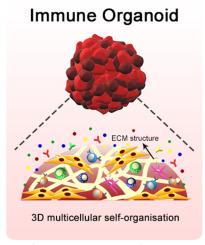为转化免疫学设计人体免疫器官组织
IF 18
1区 医学
Q1 ENGINEERING, BIOMEDICAL
引用次数: 0
摘要
动物模型已被广泛用作包括免疫学研究在内的各种生物学研究的黄金标准。尽管动物模型可用性高且易于操作,但由于物种间遗传和微环境的差异,动物模型不能充分反映人类复杂的相互作用和独特的细胞特性,从而导致临床阶段的失败。类器官技术为微型器官的组织结构和功能提供了复杂的见解,因此获得了极大的关注。在这篇综述中,我们将介绍如何利用类器官系统克服动物研究中的局限性,如与人类生理不匹配、成本高、耗时长、筛选通量低等。免疫类器官是体外器官形成的具体进展之一,它能从更多生理相关方面反映人类的适应性免疫。我们将讨论如何从患者来源的淋巴组织中建立免疫器官组织,以及它们的特点和功能特征,以了解免疫机制和反应。此外,我们还从生物工程的角度探讨了免疫工程器官组织可能取得的进展。本文章由计算机程序翻译,如有差异,请以英文原文为准。

Engineering human immune organoids for translational immunology
Animal models have been extensively used as a gold standard in various biological research, including immunological studies. Despite high availability and ease of handling procedure, they inadequately represent complex interactions and unique cellular properties in humans due to inter-species genetic and microenvironmental differences which have resulted in clinical-stage failures. Organoid technology has gained enormous attention as they provide sophisticated insights about tissue architecture and functionality in miniaturized organs. In this review, we describe the use of organoid system to overcome limitations in animal-based investigations, such as physiological mismatch with humans, costly, time-consuming, and low throughput screening. Immune organoids are one of the specific advancements in organogenesis ex vivo, which can reflect human adaptive immunity with more physiologically relevant aspects. We discuss how immune organoids are established from patient-derived lymphoid tissues, as well as their characteristics and functional features to understand immune mechanisms and responses. Also, some bioengineering perspectives are considered for any potential progress of immuno-engineered organoids.
求助全文
通过发布文献求助,成功后即可免费获取论文全文。
去求助
来源期刊

Bioactive Materials
Biochemistry, Genetics and Molecular Biology-Biotechnology
CiteScore
28.00
自引率
6.30%
发文量
436
审稿时长
20 days
期刊介绍:
Bioactive Materials is a peer-reviewed research publication that focuses on advancements in bioactive materials. The journal accepts research papers, reviews, and rapid communications in the field of next-generation biomaterials that interact with cells, tissues, and organs in various living organisms.
The primary goal of Bioactive Materials is to promote the science and engineering of biomaterials that exhibit adaptiveness to the biological environment. These materials are specifically designed to stimulate or direct appropriate cell and tissue responses or regulate interactions with microorganisms.
The journal covers a wide range of bioactive materials, including those that are engineered or designed in terms of their physical form (e.g. particulate, fiber), topology (e.g. porosity, surface roughness), or dimensions (ranging from macro to nano-scales). Contributions are sought from the following categories of bioactive materials:
Bioactive metals and alloys
Bioactive inorganics: ceramics, glasses, and carbon-based materials
Bioactive polymers and gels
Bioactive materials derived from natural sources
Bioactive composites
These materials find applications in human and veterinary medicine, such as implants, tissue engineering scaffolds, cell/drug/gene carriers, as well as imaging and sensing devices.
 求助内容:
求助内容: 应助结果提醒方式:
应助结果提醒方式:


